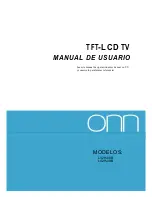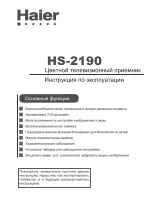
Service Modes, Error Codes, and Fault Finding
5.
5.9
Fault Finding and Repair Tips
Read also paragraph
5.9.1
Ambilight
Due to a degeneration process of the AmbiLight, it is
recommended to change all ambilight units in case one unit
needs to be repaired.
5.9.2
CSM
When you activate CSM and there is a USB stick connected to
the TV, the software will dump the complete CSM content to the
USB stick. The file (Csm.txt) will be saved in the root of your
USB stick. If this mechanism works you can conclude that a
large part of the operating system is already working (MIPS,
USB...)
5.9.3
DC/DC Converter
Introduction
•
The best way to find a failure in the DC-DC converters is to
check their starting-up sequence at “power-on via the
mains cord”, presuming that the standby microprocessor is
operational.
•
If the input voltage of DC-DC converters is around 12.7 V
(measured on decoupling capacitors 2U0W and 2U0Y and
the enable signals are “low” (active) then the output
voltages should have their normal values. The +1.2 V
supply starts-up via the ENABLE_1V2, then at least 100
ms later, the +3.3 V will be activated via ENABLE-3V3 from
the standby microprocessor. If +12 V value is less than
10 V then the last enumerated voltages will not show-up
due to the under-voltage detection circuit 7U01-1 + 6U04
and surrounding components.
Furthermore, if +12 V is less than 8 V then also +1.2 V will
not be available. The third DC-DC convertor that delivers
+1.4 V out of +12 V is started up when the ENABLE-1V2
becomes active (low) and +12 V is present. The +V
tun
generator (present only for the analogue version of China
platforms) will ge33 V for the analogue tuner as
soon as the 12 V/3.3 V DC-DC converter will start to
operate.
•
The consumption of controller IC 7U0A (for 3V3/1V2) is
around 19 mA (that means almost 200 mV drop voltage
across resistor 3U70) and the consumption of controller IC
7U0L (for 5V/1V4) is around 12mA.
•
The current capability of the DC-DC converters is quite
high (short-circuit current is 7 to 10 A), therefore if there is
a linear integrated stabiliser that, for example, delivers
1.8 V from +3.3 V with its output overloaded, the +3.3 V
stays usually at its normal value even though the
consumption from +3.3 V increases significantly.
•
The SUPPLY-FAULT signal (active low) is an internal
protection (triggering error 9) for the DC-DC convertor and
will occur if the output voltage of any DC-DC convertor is
out of limits (10% of the normal value).
Fault Finding
•
Symptom:
+1.2 V not present (even for a short while
~10 ms). See diagram B02A.
1. Check 12 V availability (resistor 3U70, MOS-FETs 7U05
and 7U06), value of +12 V, and surrounding components)
2. Check the voltage on pin 9 of 7U0A (1.5 V),
3. Check for +1.2 V output voltage short-circuit to GND that
can generate pulsed over-currents 7 to 10 A through coil
5U00.
4. Check the over-current detection circuit (2U00 or 3U17
interrupted).
•
Symptom:
+1.4 V not present (even for a short while
~10 ms) while +12 V is okay (also across input capacitors
2U8A and 2U8E). See diagram B02C.
1. Check resistor 3U3T and power MOS-FETs 7U0D-1/2.
2. Check the voltage on pin 4 of 7U0L (4 V).
3. Check enable signal ENABLE-1V2 (active “low”).
4. Check for +1.4 V output voltage short-circuit to GND that
can generate pulsed over-currents 7 to 10 A through coil
5U05.
•
Symptom:
+1.2 V present for about 100 ms, +1 V, +2.5 V
and +3.3 V not rising.
1. Check the ENABLE-3V3 signal (active “low”),
2. Check the voltage on pin 8 of IC 7U0A (1.5 V),
3. Check the under-voltage detection circuit (the voltage on
collector of transistor 7U01-1 should be less than
0.8 V),
4. Check for output voltages short-circuits to GND (+3.3 V,
+2.5 V and +1 V) that can generate pulsed over-currents
7 to 10 A through coil 5U01,
5. Check the over-current detection circuit (2U04 or 3U14
interrupted).
•
Symptom:
+1.2 V okay, but +2.5 V and +3.3 V only
present for about 100 ms.
Possible cause:
SUPPLY-
FAULT line stays “low” even though the +3.3 V and +1.2 V
are available - the stand-by microprocessor is detecting
that and switching “off” all supply voltages.
1. Check the drop voltage across resistor 3U70 (or 3U3T)
(they could be too high, meaning a defective controller IC
or MOS-FETs),
2. Check if the boost voltage on pin 4 of controller IC 7U0A
is less than 14 V (should be 19 V),
3. Check if +1.2 V or +3.3 V are higher than their normal
values - that can be due to defective DC feedback of the
respective DC-DC convertor (ex. 3U1J, 3U75).
•
Symptom:
+1.2 V, +1.4 V, +2.5 V or +3.3 V show a high
level of ripple voltage (audible noise can come from the
filtering coils 5U00, 5U01 or 5U04).
Possible cause:
instability of the frequency and/or duty cycle of a DC-DC
converter or stabiliser.
1. Check resistor 3U0H/3U2E and capacitor 2U0C/2U0A,
input and output decoupling capacitors.
2. Check a.c. feedback circuits (2U08+2U09+3U07+3U08
for +1.2 V, 2U8P+2U0Y+3U24 for +1.4 V and
2U03+2U05+3U04).
•
Symptom:
+1.2 V, +1.4 V, +2.5 V and +3.3 V ok, but no
+V
tun
(analogue sets only).
Possible cause:
the “+V
tun
generator” circuit (7U0P +7 U0Q + surroundings
components, diagram B02B) is defective: check transistor
7U0P (it has to have gate voltage pulses of about 10 V
amplitude and drain voltage pulses of about 35 V
amplitude) and surrounding components. A high
consumption (more than 6 mA) from +V
tun
voltage can
cause also +Vtun voltage to be too low or zero.
Note:
when a pair of power MOSFETs (7U02+7U08,
7U05+7U06 or 7U0D-1/2) becomes defective the controller IC
7U0A or 7U0L should be replaced as well.
5.9.4
Exit “Factory Mode”
When an “F” is displayed in the screen’s right corner, this
means that the set is in “Factory” mode, and it normally
happens after a new SSB has been mounted.
To exit this mode, push the “Volume minus” button on the TV’s
keyboard control for 5 seconds and restart the set.
















































